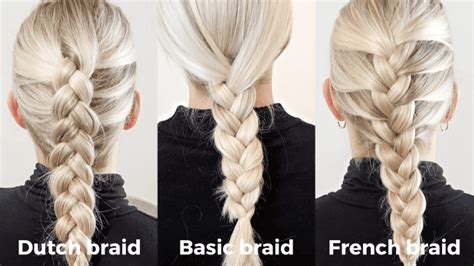Introduction
Braiding is a versatile and timeless hair styling technique that has been practiced for centuries. Two of the most popular braiding styles are Dutch braids and French braids. While both techniques result in intricate and aesthetically pleasing braids, they have distinct characteristics and suit different hair types and preferences. This comprehensive guide will delve into the similarities and differences between Dutch braids and French braids, providing step-by-step instructions, highlighting key features, and offering tips for achieving the perfect braid.

Key Features of Dutch Braids and French Braids
Dutch Braids
- Also known as an inside-out braid
- Hair is divided into three strands, with the outermost strands crossed under the middle strand to create a “zigzag” effect
- Hair is added to the outermost strands as you braid down
- Results in a raised and textured braid that sits on top of the head
French Braids
- Also known as an outside-in braid
- Hair is divided into three strands, with the outermost strands crossed over the middle strand, creating an “overlapping” effect
- Hair is added to the outermost strands as you braid down
- Results in a flatter and more delicate braid that sits closer to the scalp
Similarities and Differences
Similarities:
- Both techniques involve dividing hair into three strands and braiding down the length of the hair
- Both styles can be used to create a variety of hairstyles, from simple everyday braids to intricate updos
- Both techniques require practice and skill to achieve a polished look
Differences:
- Direction of strands: Dutch braids cross the strands under the middle strand, while French braids cross them over the middle strand
- Texture: Dutch braids result in a raised and textured braid, while French braids are flatter and more delicate
- Height: Dutch braids sit on top of the head, while French braids sit closer to the scalp
- Suitability: Dutch braids are better suited for thicker and coarser hair, while French braids are ideal for finer and straighter hair
Step-by-Step Instructions
Dutch Braid
Materials:
- Hairbrush
- Hairspray (optional)
Instructions:
- Start with slightly damp hair.
- Brush hair to remove any tangles.
- Divide hair into three equal strands at the top of the head.
- Cross the left strand under the middle strand.
- Cross the right strand under the new middle strand.
- Take a small section of hair from the left side and add it to the left strand.
- Cross the left strand (including the added hair) under the middle strand.
- Repeat steps 5-7 with the right strand.
- Continue braiding down the length of the hair, adding hair to the outermost strands as you go.
- Secure the end of the braid with an elastic band.
- Spray hairspray to hold the braid in place (optional).
French Braid
Materials:
- Hairbrush
- Hairspray (optional)
Instructions:
- Start with slightly damp hair.
- Brush hair to remove any tangles.
- Divide hair into three equal strands at the top of the head.
- Cross the left strand over the middle strand.
- Cross the right strand over the new middle strand.
- Take a small section of hair from the left side and add it to the left strand.
- Cross the left strand (including the added hair) over the middle strand.
- Repeat steps 5-7 with the right strand.
- Continue braiding down the length of the hair, adding hair to the outermost strands as you go.
- Secure the end of the braid with an elastic band.
- Spray hairspray to hold the braid in place (optional).
Tips for Success
- Practice makes perfect: The key to mastering both Dutch and French braids is practice. The more you practice, the more comfortable and proficient you will become.
- Use a mirror: If you struggle to braid your own hair, use a mirror to help you visualize the strands and their direction.
- Tighten the strands: As you braid, make sure to tighten the strands around the middle strand to create a secure and defined braid.
- Add hair evenly: When adding hair to the outermost strands, be sure to do so evenly to maintain the balance and symmetry of the braid.
- Experiment with different styles: Once you have mastered the basic techniques, experiment with different braid patterns and embellishments to create unique and eye-catching hairstyles.
Conclusion
Dutch braids and French braids are two versatile and stylish braiding techniques that can add a touch of elegance and sophistication to any look. Whether you want a raised and textured braid for a special occasion or a delicate and flattering braid for everyday wear, understanding the key differences between these techniques will help you achieve the perfect braid for your hair type and preferences. With practice and a bit of creativity, you can master both Dutch and French braids and create a wide range of beautiful hairstyles.
